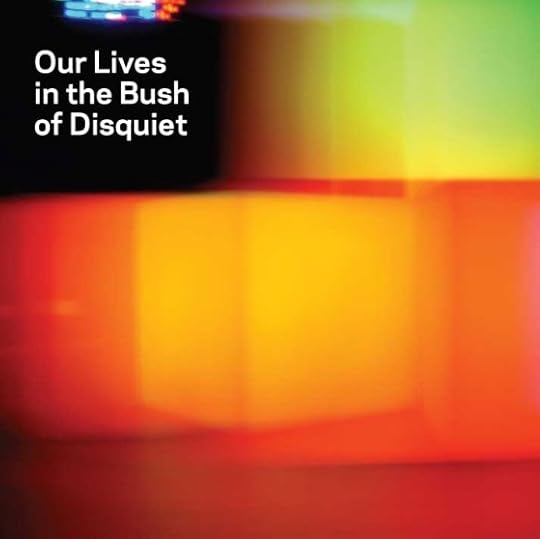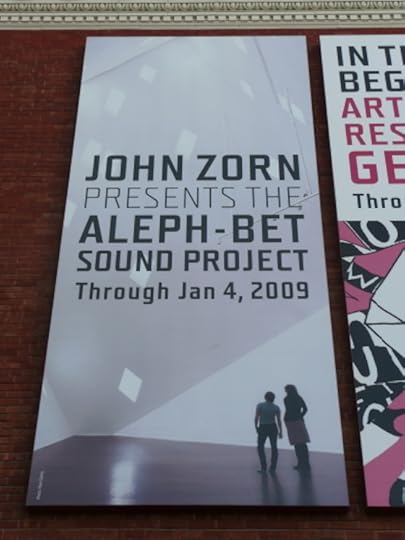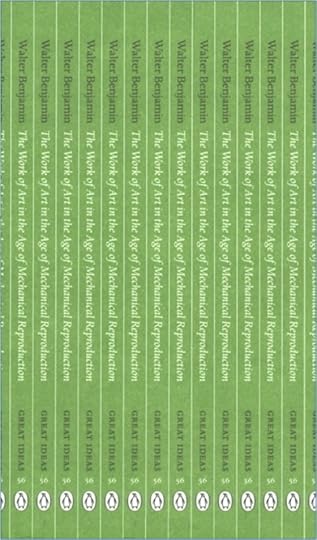Marc Weidenbaum's Blog, page 437
January 4, 2014
Disquiet: 15, 10 & 5 Years Ago This Week (2014.01)
This would be roughly the week of December 30 through January 5.

5 Years Ago (2008): My top-of-2008 list included commercial albums (among them Unitxt by Alva Noto and The Elephant in the Room: 3 Commissions by Mira Calix), free downloads (among them Wobbly’s massive birdsong megamix and computer-addled metal by Drumcorps), and “key processes” (among them the continued rise of netlabels, ambient movie scores, and fetishized sound objects). … At the start of January 2009, I’d checked in on the listens to the Our Lives in the Bush of Disquiet project I had put together in September 2006, and noted that it had over 25,000 downloads. The album collected reworkings of music from My Life in the Bush of Ghosts by Brian Eno and David Byrne, who had put up stems from the album for open-source remixing. Participants included Brian Biggs (aka Dance Robot Dance), Roddy Schrock, Stephane Leonard, John Kannenberg, My Fun, and Mark Rushton. As of this writing, a week or so before 2014, the release is making its way toward 60,000: it has had almost 41,000 downloads on archive.org and an additional 15,000 or so at freemusicarchive.org. In many ways, that Bush of Disquiet endeavor started me down the course that led to the weekly Disquiet Junto projects. … The last two Downstream entries of the year were a piece made on a Nintendo DS port of the Korg DS-10 and piano-based music by Emmanuel Witzthum released on the Stasisfield netlabel. … Among the first Downstream entries of the new year, 2009, were historic Frippertronics pieces from 1978, some Austrian d’n'b, and Berlin sound art. … The quote of the week was Nico Muhly on working with tape. … The image of the week was a taxi-based sound-art project by Staalplaat Soundsystem, from a New Delhi residency. … I posted brief reviews of a DJ Rob Swift album (Dust to Dust) and the score by Alex Wurman to the film What Doesn’t Kill You. … And I wrote about the John Zorn–curated sound installation at the then recently opened Contemporary Jewish Museum in San Francisco:

10 Years Ago (2003): My best albums of 2003 list was posted this week. It included Matmos’ The Civil War, Rhythm and Sound’s The Artists and The Versions, and Brian Eno’s January 07003: Bell Studies for the Clock of the Long Now. … The first Downstream entry of the year was Human Isolated Bacteria’s Boleros Románticos de Ayer y Hoy (“blippy background jazz, groovy syncopation and whiz bang party music, with occasional bridges of timeless suspense”).
15 Years Ago (1998): My best albums of 1998 list was posted this week. It included Amon Tobin’s Permutation, Autechre’s LP5, and Praxis’ Mold.
Past Week at Twitter.com/Disquiet
"Record the sound of ice in a glass and make something of it." http://t.co/ebeTjqHF7E. The 1st @djunto of 2014, 105th overall. ->
OK, now that I've posted the first Disquiet Junto project of the new year, I go back into social-network slumber until Monday, January 6. ->
January 2, 2014
Disquiet Junto Project 0105: Ice for 2014

Each Thursday at the Disquiet Junto group on SoundCloud.com a new compositional challenge is set before the group’s members, who then have just over four days to upload a track in response to the assignment. Membership in the Junto is open: just join and participate.
This project was published in the evening, California time, on Thursday, January 2, with 11:59pm on the following Monday, January 6, 2014, as the deadline.
These are the instructions that went out to the group’s email list (at tinyletter.com/disquiet-junto):
Disquiet Junto Project 0105: Ice for 2014
Happy new year! This week’s project is as follows:
Please record the sound of an ice cube rattling in a glass, and make something of it.
Background: Longtime participants in, and observers of, the Disquiet Junto series will recognize this single sentence as the very first Disquiet Junto project, the same one that launched the series on the first Thursday of 2012. Revisiting it a year later, on the first Thursday of 2013, provided a fitting way to begin the new year. Now, at the start of the third year of the Disquiet Junto, it is something of a tradition. A weekly project series can come to overemphasize novelty, and it’s helpful to revisit old projects as much as it is to engage with new ones. Also, by its very nature, the Disquiet Junto suggests itself as a fast pace: a four-day production window, a weekly habit. It’s beneficial to step back and see things from a longer perspective.
Deadline: Monday, January 6, 2014, at 11:59pm wherever you are.
Length: Your finished work should be between 2 and 4 minutes in length.
Information: Please when posting your track on SoundCloud, include a description of your process in planning, composing, and recording it. This description is an essential element of the communicative process inherent in the Disquiet Junto.
Title/Tag: When adding your track to the Disquiet Junto group on Soundcloud.com, please include the term “disquiet0105-ice2014” in the title of your track, and as a tag for your track.
Download: It is preferable that your track is set as downloadable, and that it allows for attributed remixing (i.e., a Creative Commons license permitting non-commercial sharing with attribution).
Linking: When posting the track, be sure to include this information:
More on this 105th Disquiet Junto project (“Record the sound of ice in a glass and make something of it”) at:
http://disquiet.com/2014/01/02/disqui...
More on the Disquiet Junto at:
Join the Disquiet Junto at:
http://soundcloud.com/groups/disquiet...
Photo associated with this project found via Creative Commons at:
January 1, 2014
New Year Dub
One of the beauties of SoundCloud.com is the casual nature of much of its content. Musicians upload not only finished recordings but works-in-progress, which serve as windows into their creative process, arguably providing a more intimate, fluid, and digitally natural listening experience that do sites whose structure is more clearly modeled on the brick’n'mortar system of a traditional record store. Often as not, these experimental, mid-process SoundCloud-housed tracks are brief, in the one-minute range, though in the realm of electronic music, they are only short on first listen — they are then adapted by fellow musicians (unfolding into myriad remixes), or simply set on loop.
A one-minute dub track, such as Kyle TM’s “New Year Dub,” easily turns into a half-hour of trance-worthy listening. In fact, while many short pieces on SoundCloud merely make for repeat listening, in this case it’s Kyle TM’s intent: “Meant to be looped,” he writes in a brief accompanying liner note. The piece has a familiar dub reggae rhythm, tweaked with a squeaky, delectably sour, further-off-the-beat percussive, like a screw is loose somewhere in the sound system.
Track originally posted for free download at soundcloud.com/kyletm. More from Kyle TM, who’s based in Greer, South Carolina, at thekyletm.tumblr.com and twitter.com/thekyletm.
December 28, 2013
Disquiet: 15, 10 & 5 Years Ago This Week (2013.52)
This would be roughly the week of December 23 through December 29.

5 Years Ago (2008): A feature collected this site’s readers’ favorite albums of 2008. … The quote of the week collated material from Fringe, among it: “Was I humming? I thought it was in my head. … Nothing sings like a kilo volt. Unique pitch. Nothing else in nature quite like it.” … The image of the week was the cover to the then new edition of a Penguin paperback of Walter Benjamin’s The Work of Art in the Age of Mechanical Reproduction. … The week’s Downstream entries included some 8-bit Christmas music, a raucous drone by Growing, Esther Venrooy’s saw-toothed wave forms, jazz remixes from Silences Sumire (aka Thomas Faulds and Charles Gorcyznski), and foghorn-tronic material from Stray Ghost.
10 Years Ago (2003): My favorite albums of 2003, in a post this week, included Quartets by Boxhead Ensemble (to this day a major favorite — I briefly considered pitching it to 33 1/3 instead of Aphex Twin’s Selected Ambient Works Volume II), Systems/Layers by Rachel’s, and So by So (aka Markus Popp and Eriko Toyada). … I must have been taking an end-of-year break, because there were no Downstream entries.
15 Years Ago (1998): Nothing this week.
Past Week at Twitter.com/Disquiet
Note: I’m taking something of a social-media break through January 6, 2014.
Tuesday noon siren in San Francisco: http://t.co/FrVmKgO1Mx ->
New @djunto project begins later today. (Email alert: http://t.co/pavSZXDG7u.) Now I'm returning to my end-of-year social-media hibernation. ->
December 26, 2013
Disquiet Junto Project 0104: 2013 in 60 Seconds

Each Thursday at the Disquiet Junto group on SoundCloud.com a new compositional challenge is set before the group’s members, who then have just over four days to upload a track in response to the assignment. Membership in the Junto is open: just join and participate.
This project was published in the evening, California time, on Thursday, December 26, with 11:59pm on the following Monday, December 30, 2013, as the deadline.
These are the instructions that went out to the group’s email list (at tinyletter.com/disquiet-junto):
Disquiet Junto Project 0104: 2013 in 60 Seconds
This week’s project is a sound journal, an audio history of the past year. You will select a different audio element to represent each of the past 12 months of 2013. You will then select one 5-second segment from each of these audio elements. Then you will stitch these dozen 5-second segments together in chronological order to form 1 single 1-minute track. There should be no overlap or gap between segments; they should simply proceed from one to the next.
These audio elements will most likely be of music that you have yourself composed and recorded, but they might also consist of phone messages, field recordings, or other source material. These items should be somehow personal in nature, suitable to the autobiographical intention of the project; they should preferably of your own making, and not drawn from third-party sources.
Deadline: Monday, December 30, at 11:59pm wherever you are.
Length: Your finished work should be 60 seconds long.
Information: Please, when posting your track on SoundCloud, list the source of each of the 12 elements.
Title/Tag: When adding your track to the Disquiet Junto group on Soundcloud.com, please include the term “disquiet0104-audiojournal2013” in the title of your track, and as a tag for your track.
Download: It is preferable that your track is set as downloadable, and that it allows for attributed remixing (i.e., a Creative Commons license permitting non-commercial sharing with attribution).
Linking: When posting your track, be sure to include this information:
More on this 104th Disquiet Junto project (“Create a 2013 audio diary with a dozen five-second segments”) at:
http://disquiet.com/2013/12/26/disqui...
More details on the Disquiet Junto at:
Join the Disquiet Junto at:
http://soundcloud.com/groups/disquiet...
Photo associated with this project found via Creative Commons at:
December 22, 2013
One Prayer Bowl Ringing

The sound of one prayer bowl ringing is quite a bit more than the familiar lulling waveform when that ringing is sent through myriad processing routines. This is why while Jason Charney’s “Pratītya,” named for the Buddhist concept of “pratītyasamutpāda,” veers from its opening ring tone, that which follows — overtones, and cicada chatter, percussive tweaks — always seems rooted in the source audio.
Track originally posted for free download at soundcloud.com/jasoncharney. More from Charney, who is based in Ohio, at jasoncharney.com and twitter.com/jcharney.
December 21, 2013
Disquiet: 15, 10 & 5 Years Ago This Week (2013.51)

5 Years Ago (2008): This week I was in Tokyo, where I came upon a book titled Art Space Tokyo: An Intimate Guide to the Tokyo Art World. I was headed to a concert at the club Super Deluxe, so I didn’t but a copy, which was unfortunate because it quickly went out of print and sold for hundreds of dollars in the second-hand market. Later, in 2010, the book was a successful early Kickstarter project for a reprint and iPad edition, which finally appeared in mid-2012. There’s a free browser-based version, too. Anyhow, my quote of the week in mid-December 2008 was from the book. This is Roger McDonald: “This sense of physical impermanence makes Tokyo something like a huge, ever-evolving John Cage composition, whirling itself through chance procedures and the interventions of its inhabitants/users.”

The image of the week, a 1940s listening device shown in this post, was found via the musician and sound artist Steve Roden’s ephemera-rich blog. … In the Downstream department of legally free downloads: C. Reider reworking nine other musicians’ work, mischievous Morse code from Sublamp (aka Ryan Connor), the collaboration of James Blackshaw and Jozef Van Wissem, and Jonathan Coleclough’s amplified sounds. Many of those offsite links have, inevitably, since expired.
10 Years Ago (2003): I did a holiday gift guide this week, with recommendations based on category (a broader concept than genre), such as “quietly deceptive” (Doron Sadja’s A Piece of String, a Sunset) and “historic” (James Tenney’s Selected Works 1961-1969). … In the Downstream departent of legally free downloads: a Nurse with Wound tribute album, some “songwriting as sine wave” by Sophrosyne (aka Jason van Pelt), various live recordings by Christopher Willits, and video by Keith Fullerton Whitman (then still better known, perhaps, as Hrvatski). Many of those offsite links have, inevitably, since expired.
15 Years Ago (1998): No posts this week 15 years ago.
Past Week at Twitter.com/Disquiet
Note: I’m taking something of a social-media break through January 6, 2014
Tuesday noon siren in San Francisco: http://t.co/FrVmKgO1Mx ->



